Attached files
| file | filename |
|---|---|
| EX-32.1 - EX-32.1 - Monotype Imaging Holdings Inc. | d321156dex321.htm |
| EX-31.2 - EX-31.2 - Monotype Imaging Holdings Inc. | d321156dex312.htm |
| EX-31.1 - EX-31.1 - Monotype Imaging Holdings Inc. | d321156dex311.htm |
| EX-23.1 - EX-23.1 - Monotype Imaging Holdings Inc. | d321156dex231.htm |
| EX-21.1 - EX-21.1 - Monotype Imaging Holdings Inc. | d321156dex211.htm |
| EX-4.1 - EX-4.1 - Monotype Imaging Holdings Inc. | d321156dex41.htm |
| 10-K - FORM 10-K - Monotype Imaging Holdings Inc. | d321156d10k.htm |
Exhibit 10.32
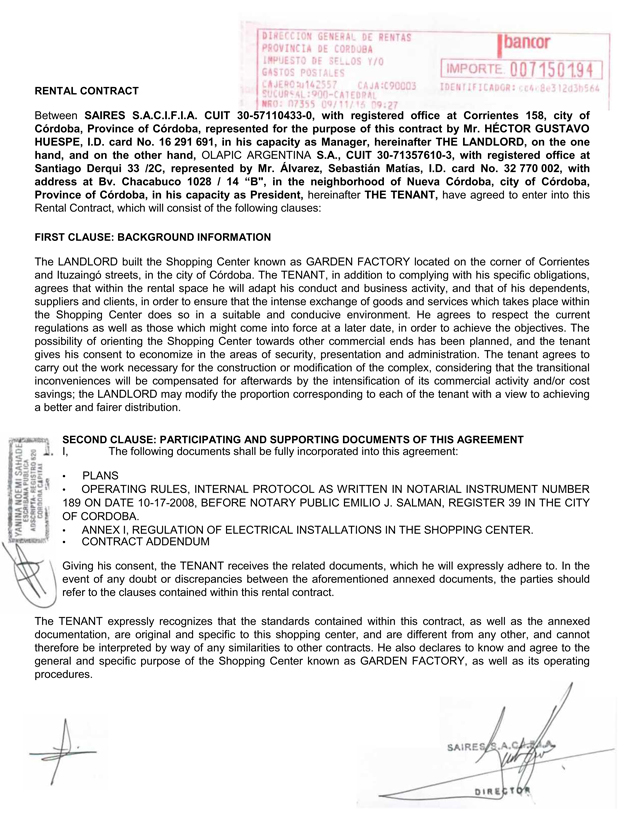
RENTAL CONTRACT
Between SAIRES S.A.C.I.F.I.A. CUIT 30-57110433-0, with registered office at Corrientes 158, city of Córdoba, Province of Córdoba, represented for the purpose of this contract by Mr. HÉCTOR GUSTAVO HUESPE, I.D. card No. 16 291 691, in his capacity as Manager, hereinafter THE LANDLORD, on the one hand, and on the other hand, OLAPIC ARGENTINA S.A., CUIT 30-71357610-3, with registered office at Santiago Derqui 33 /2C, represented by Mr. Álvarez, Sebastián Matías, I.D. card No. 32 770 002, with address at Bv. Chacabuco 1028 / 14 “B”, in the neighborhood of Nueva Córdoba, city of Córdoba, Province of Córdoba, in his capacity as President, hereinafter THE TENANT, have agreed to enter into this Rental Contract, which will consist of the following clauses:
FIRST CLAUSE: BACKGROUND INFORMATION
The LANDLORD built the Shopping Center known as GARDEN FACTORY located on the corner of Corrientes and Ituzaingó streets, in the city of Córdoba. The TENANT, in addition to complying with his specific obligations, agrees that within the rental space he will adapt his conduct and business activity, and that of his dependents, suppliers and clients, in order to ensure that the intense exchange of goods and services which takes place within the Shopping Center does so in a suitable and conducive environment. He agrees to respect the current regulations as well as those which might come into force at a later date, in order to achieve the objectives. The possibility of orienting the Shopping Center towards other commercial ends has been planned, and the tenant gives his consent to economize in the areas of security, presentation and administration. The tenant agrees to carry out the work necessary for the construction or modification of the complex, considering that the transitional inconveniences will be compensated for afterwards by the intensification of its commercial activity and/or cost savings; the LANDLORD may modify the proportion corresponding to each of the tenant with a view to achieving a better and fairer distribution.
SECOND CLAUSE: PARTICIPATING AND SUPPORTING DOCUMENTS OF THIS AGREEMENT
I, The following documents shall be fully incorporated into this agreement:
PLANS
OPERATING RULES, INTERNAL PROTOCOL AS WRITTEN IN NOTARIAL INSTRUMENT NUMBER 189 ON DATE 10-17-2008, BEFORE NOTARY PUBLIC EMILIO J. SALMAN, REGISTER 39 IN THE CITY OF CORDOBA.
ANNEX I, REGULATION OF ELECTRICAL INSTALLATIONS IN THE SHOPPING CENTER.
CONTRACT ADDENDUM
Giving his consent, the TENANT receives the related documents, which he will expressly adhere to. In the event of any doubt or discrepancies between the aforementioned annexed documents, the parties should refer to the clauses contained within this rental contract.
The TENANT expressly recognizes that the standards contained within this contract, as well as the annexed documentation, are original and specific to this shopping center, and are different from any other, and cannot therefore be interpreted by way of any similarities to other contracts. He also declares to know and agree to the general and specific purpose of the Shopping Center known as GARDEN FACTORY, as well as its operating procedures.
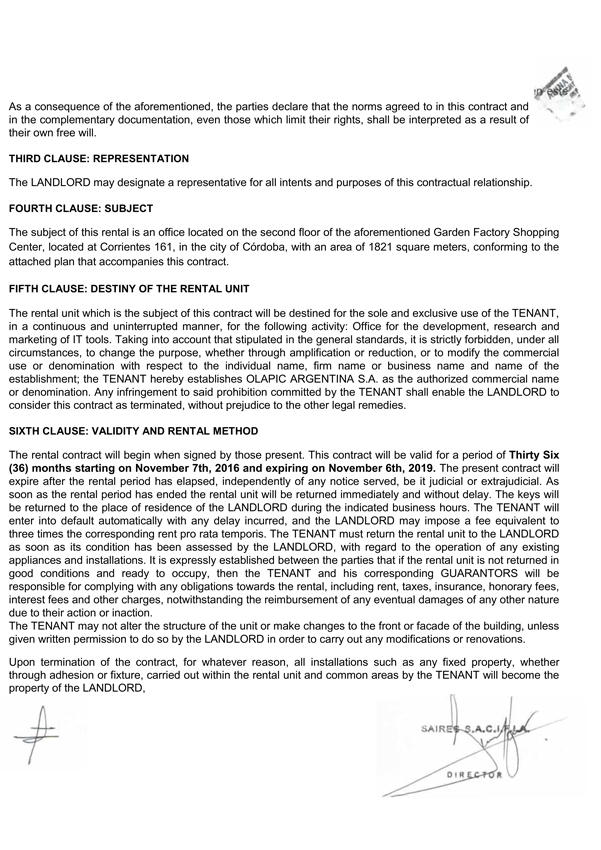
As a consequence of the aforementioned, the parties declare that the norms agreed to in this contract and in the complementary documentation, even those which limit their rights, shall be interpreted as a result of their own free will.
THIRD CLAUSE: REPRESENTATION
The LANDLORD may designate a representative for all intents and purposes of this contractual relationship.
FOURTH CLAUSE: SUBJECT
The subject of this rental is an office located on the second floor of the aforementioned Garden Factory Shopping Center, located at Corrientes 161, in the city of Córdoba, with an area of 1821 square meters, conforming to the attached plan that accompanies this contract.
FIFTH CLAUSE: DESTINY OF THE RENTAL UNIT
The rental unit which is the subject of this contract will be destined for the sole and exclusive use of the TENANT, in a continuous and uninterrupted manner, for the following activity: Office for the development, research and marketing of IT tools. Taking into account that stipulated in the general standards, it is strictly forbidden, under all circumstances, to change the purpose, whether through amplification or reduction, or to modify the commercial use or denomination with respect to the individual name, firm name or business name and name of the establishment; the TENANT hereby establishes OLAPIC ARGENTINA S.A. as the authorized commercial name or denomination. Any infringement to said prohibition committed by the TENANT shall enable the LANDLORD to consider this contract as terminated, without prejudice to the other legal remedies.
SIXTH CLAUSE: VALIDITY AND RENTAL METHOD
The rental contract will begin when signed by those present. This contract will be valid for a period of Thirty Six (36) months starting on November 7th, 2016 and expiring on November 6th, 2019. The present contract will expire after the rental period has elapsed, independently of any notice served, be it judicial or extrajudicial. As soon as the rental period has ended the rental unit will be returned immediately and without delay. The keys will be returned to the place of residence of the LANDLORD during the indicated business hours. The TENANT will enter into default automatically with any delay incurred, and the LANDLORD may impose a fee equivalent to three times the corresponding rent pro rata temporis. The TENANT must return the rental unit to the LANDLORD as soon as its condition has been assessed by the LANDLORD, with regard to the operation of any existing appliances and installations. It is expressly established between the parties that if the rental unit is not returned in good conditions and ready to occupy, then the TENANT and his corresponding GUARANTORS will be responsible for complying with any obligations towards the rental, including rent, taxes, insurance, honorary fees, interest fees and other charges, notwithstanding the reimbursement of any eventual damages of any other nature due to their action or inaction.
The TENANT may not alter the structure of the unit or make changes to the front or facade of the building, unless given written permission to do so by the LANDLORD in order to carry out any modifications or renovations.
Upon termination of the contract, for whatever reason, all installations such as any fixed property, whether through adhesion or fixture, carried out within the rental unit and common areas by the TENANT will become the property of the LANDLORD,
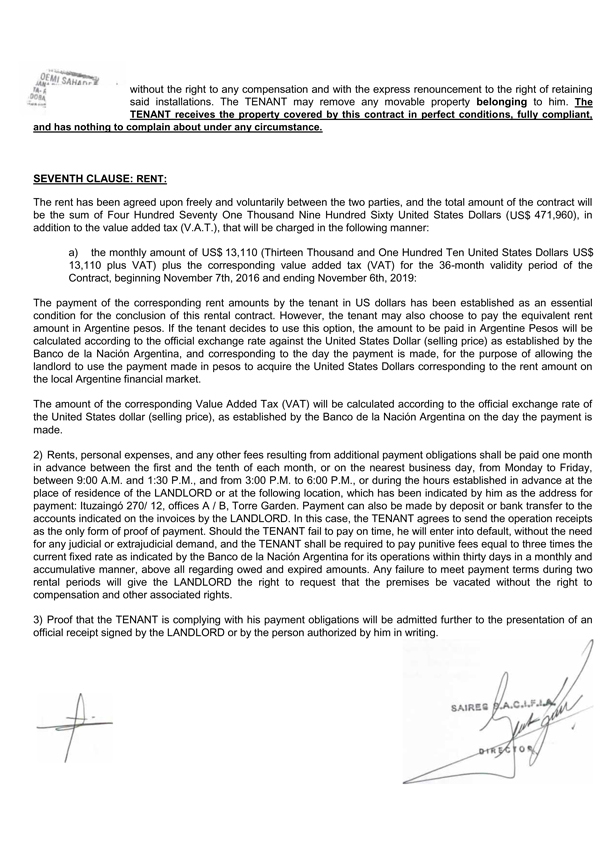
without the right to any compensation and with the express renouncement to the right of retaining said installations. The TENANT may remove any movable property belonging to him. The TENANT receives the property covered by this contract in perfect conditions, fully compliant, and has nothing to complain about under any circumstance.
SEVENTH CLAUSE: RENT:
The rent has been agreed upon freely and voluntarily between the two parties, and the total amount of the contract will be the sum of Four Hundred Seventy One Thousand Nine Hundred Sixty United States Dollars (US$ 471,960), in addition to the value added tax (V.A.T.), that will be charged in the following manner:
a) the monthly amount of US$ 13,110 (Thirteen Thousand and One Hundred Ten United States Dollars US$ 13,110 plus VAT) plus the corresponding value added tax (VAT) for the 36-month validity period of the Contract, beginning November 7th, 2016 and ending November 6th, 2019:
The payment of the corresponding rent amounts by the tenant in US dollars has been established as an essential condition for the conclusion of this rental contract. However, the tenant may also choose to pay the equivalent rent amount in Argentine pesos. If the tenant decides to use this option, the amount to be paid in Argentine Pesos will be calculated according to the official exchange rate against the United States Dollar (selling price) as established by the Banco de la Nación Argentina, and corresponding to the day the payment is made, for the purpose of allowing the landlord to use the payment made in pesos to acquire the United States Dollars corresponding to the rent amount on the local Argentine financial market.
The amount of the corresponding Value Added Tax (VAT) will be calculated according to the official exchange rate of the United States dollar (selling price), as established by the Banco de la Nación Argentina on the day the payment is made.
2) Rents, personal expenses, and any other fees resulting from additional payment obligations shall be paid one month in advance between the first and the tenth of each month, or on the nearest business day, from Monday to Friday, between 9:00 A.M. and 1:30 P.M., and from 3:00 P.M. to 6:00 P.M., or during the hours established in advance at the place of residence of the LANDLORD or at the following location, which has been indicated by him as the address for payment: Ituzaingó 270/ 12, offices A / B, Torre Garden. Payment can also be made by deposit or bank transfer to the accounts indicated on the invoices by the LANDLORD. In this case, the TENANT agrees to send the operation receipts as the only form of proof of payment. Should the TENANT fail to pay on time, he will enter into default, without the need for any judicial or extrajudicial demand, and the TENANT shall be required to pay punitive fees equal to three times the current fixed rate as indicated by the Banco de la Nación Argentina for its operations within thirty days in a monthly and accumulative manner, above all regarding owed and expired amounts. Any failure to meet payment terms during two rental periods will give the LANDLORD the right to request that the premises be vacated without the right to compensation and other associated rights.
3) Proof that the TENANT is complying with his payment obligations will be admitted further to the presentation of an official receipt signed by the LANDLORD or by the person authorized by him in writing.
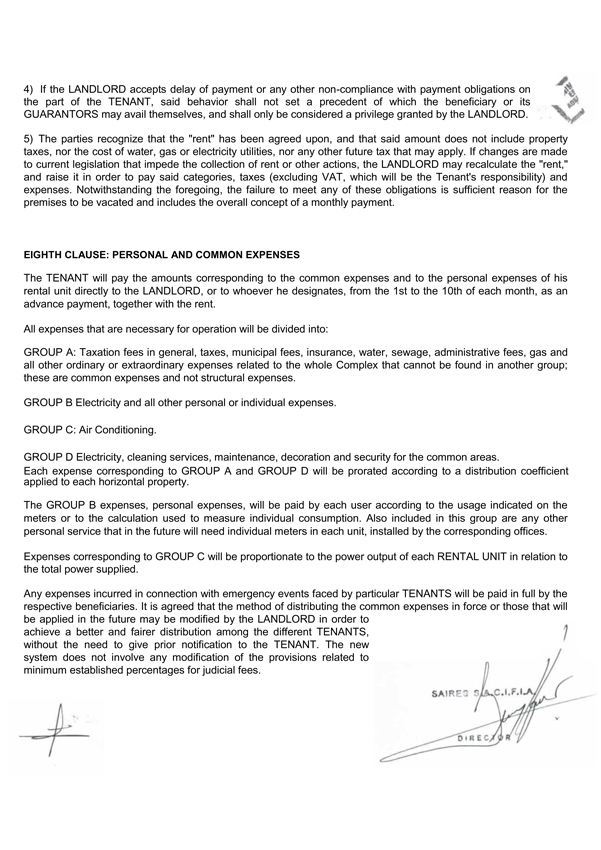
4) If the LANDLORD accepts delay of payment or any other non-compliance with payment obligations on the part of the TENANT, said behavior shall not set a precedent of which the beneficiary or its GUARANTORS may avail themselves, and shall only be considered a privilege granted by the LANDLORD.
5) The parties recognize that the “rent” has been agreed upon, and that said amount does not include property taxes, nor the cost of water, gas or electricity utilities, nor any other future tax that may apply. If changes are made to current legislation that impede the collection of rent or other actions, the LANDLORD may recalculate the “rent,” and raise it in order to pay said categories, taxes (excluding VAT, which will be the Tenant’s responsibility) and expenses. Notwithstanding the foregoing, the failure to meet any of these obligations is sufficient reason for the premises to be vacated and includes the overall concept of a monthly payment.
EIGHTH CLAUSE: PERSONAL AND COMMON EXPENSES
The TENANT will pay the amounts corresponding to the common expenses and to the personal expenses of his rental unit directly to the LANDLORD, or to whoever he designates, from the 1st to the 10th of each month, as an advance payment, together with the rent.
All expenses that are necessary for operation will be divided into:
GROUP A: Taxation fees in general, taxes, municipal fees, insurance, water, sewage, administrative fees, gas and all other ordinary or extraordinary expenses related to the whole Complex that cannot be found in another group; these are common expenses and not structural expenses.
GROUP B Electricity and all other personal or individual expenses.
GROUP C: Air Conditioning.
GROUP D Electricity, cleaning services, maintenance, decoration and security for the common areas.
Each expense corresponding to GROUP A and GROUP D will be prorated according to a distribution coefficient applied to each horizontal property.
The GROUP B expenses, personal expenses, will be paid by each user according to the usage indicated on the meters or to the calculation used to measure individual consumption. Also included in this group are any other personal service that in the future will need individual meters in each unit, installed by the corresponding offices.
Expenses corresponding to GROUP C will be proportionate to the power output of each RENTAL UNIT in relation to the total power supplied.
Any expenses incurred in connection with emergency events faced by particular TENANTS will be paid in full by the respective beneficiaries. It is agreed that the method of distributing the common expenses in force or those that will be applied in the future may be modified by the LANDLORD in order to achieve a better and fairer distribution among the different TENANTS, without the need to give prior notification to the TENANT. The new system does not involve any modification of the provisions related to minimum established percentages for judicial fees.
NINTH CLAUSE: LANDLORD’S RESERVATION OF RIGHTS
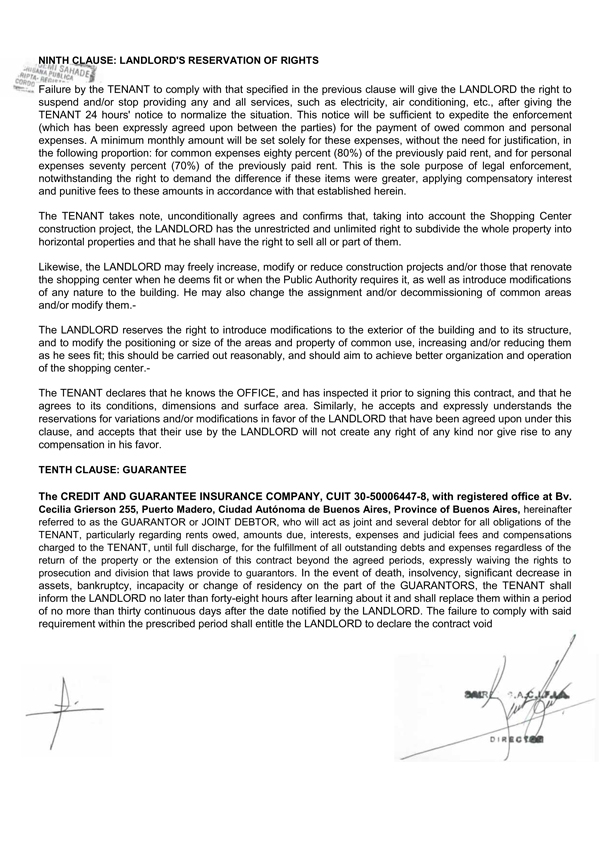
NINTH CLAUSE: LANDLORD’S RESERVATION OF RIGHTS
Failure by the TENANT to comply with that specified in the previous clause will give the LANDLORD the right to suspend and/or stop providing any and all services, such as electricity, air conditioning, etc., after giving the TENANT 24 hours’ notice to normalize the situation. This notice will be sufficient to expedite the enforcement (which has been expressly agreed upon between the parties) for the payment of owed common and personal expenses. A minimum monthly amount will be set solely for these expenses, without the need for justification, in the following proportion: for common expenses eighty percent (80%) of the previously paid rent, and for personal expenses seventy percent (70%) of the previously paid rent. This is the sole purpose of legal enforcement, notwithstanding the right to demand the difference if these items were greater, applying compensatory interest and punitive fees to these amounts in accordance with that established herein.
The TENANT takes note, unconditionally agrees and confirms that, taking into account the Shopping Center construction project, the LANDLORD has the unrestricted and unlimited right to subdivide the whole property into horizontal properties and that he shall have the right to sell all or part of them.
Likewise, the LANDLORD may freely increase, modify or reduce construction projects and/or those that renovate the shopping center when he deems fit or when the Public Authority requires it, as well as introduce modifications of any nature to the building. He may also change the assignment and/or decommissioning of common areas and/or modify them.-
The LANDLORD reserves the right to introduce modifications to the exterior of the building and to its structure, and to modify the positioning or size of the areas and property of common use, increasing and/or reducing them as he sees fit; this should be carried out reasonably, and should aim to achieve better organization and operation of the shopping center.-
The TENANT declares that he knows the OFFICE, and has inspected it prior to signing this contract, and that he agrees to its conditions, dimensions and surface area. Similarly, he accepts and expressly understands the reservations for variations and/or modifications in favor of the LANDLORD that have been agreed upon under this clause, and accepts that their use by the LANDLORD will not create any right of any kind nor give rise to any compensation in his favor.
TENTH CLAUSE: GUARANTEE
The CREDIT AND GUARANTEE INSURANCE COMPANY, CUIT 30-50006447-8, with registered office at Bv. Cecilia Grierson 255, Puerto Madero, Ciudad Autónoma de Buenos Aires, Province of Buenos Aires, hereinafter referred to as the GUARANTOR or JOINT DEBTOR, who will act as joint and several debtor for all obligations of the TENANT, particularly regarding rents owed, amounts due, interests, expenses and judicial fees and compensations charged to the TENANT, until full discharge, for the fulfillment of all outstanding debts and expenses regardless of the return of the property or the extension of this contract beyond the agreed periods, expressly waiving the rights to prosecution and division that laws provide to guarantors. In the event of death, insolvency, significant decrease in assets, bankruptcy, incapacity or change of residency on the part of the GUARANTORS, the TENANT shall inform the LANDLORD no later than forty-eight hours after learning about it and shall replace them within a period of no more than thirty continuous days after the date notified by the LANDLORD. The failure to comply with said requirement within the prescribed period shall entitle the LANDLORD to declare the contract void
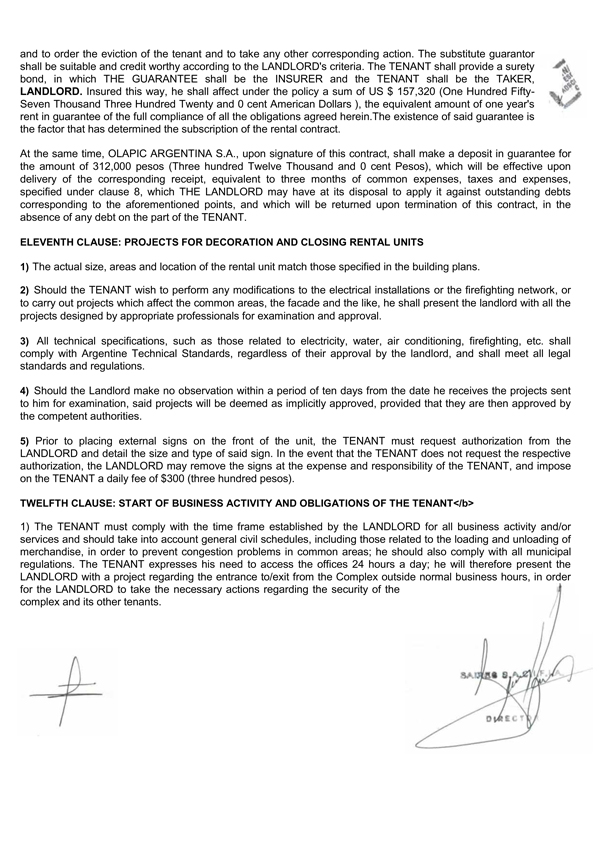
and to order the eviction of the tenant and to take any other corresponding action. The substitute guarantor shall be suitable and credit worthy according to the LANDLORD’s criteria. The TENANT shall provide a surety bond, in which THE GUARANTEE shall be the INSURER and the TENANT shall be the TAKER, LANDLORD. Insured this way, he shall affect under the policy a sum of US $ 157,320 (One Hundred Fifty-Seven Thousand Three Hundred Twenty and 0 cent American Dollars ), the equivalent amount of one year’s rent in guarantee of the full compliance of all the obligations agreed herein.The existence of said guarantee is the factor that has determined the subscription of the rental contract.
At the same time, OLAPIC ARGENTINA S.A., upon signature of this contract, shall make a deposit in guarantee for the amount of 312,000 pesos (Three hundred Twelve Thousand and 0 cent Pesos), which will be effective upon delivery of the corresponding receipt, equivalent to three months of common expenses, taxes and expenses, specified under clause 8, which THE LANDLORD may have at its disposal to apply it against outstanding debts corresponding to the aforementioned points, and which will be returned upon termination of this contract, in the absence of any debt on the part of the TENANT.
ELEVENTH CLAUSE: PROJECTS FOR DECORATION AND CLOSING RENTAL UNITS
1) The actual size, areas and location of the rental unit match those specified in the building plans.
2) Should the TENANT wish to perform any modifications to the electrical installations or the firefighting network, or to carry out projects which affect the common areas, the facade and the like, he shall present the landlord with all the projects designed by appropriate professionals for examination and approval.
3) All technical specifications, such as those related to electricity, water, air conditioning, firefighting, etc. shall comply with Argentine Technical Standards, regardless of their approval by the landlord, and shall meet all legal standards and regulations.
4) Should the Landlord make no observation within a period of ten days from the date he receives the projects sent to him for examination, said projects will be deemed as implicitly approved, provided that they are then approved by the competent authorities.
5) Prior to placing external signs on the front of the unit, the TENANT must request authorization from the LANDLORD and detail the size and type of said sign. In the event that the TENANT does not request the respective authorization, the LANDLORD may remove the signs at the expense and responsibility of the TENANT, and impose on the TENANT a daily fee of $300 (three hundred pesos).
TWELFTH CLAUSE: START OF BUSINESS ACTIVITY AND OBLIGATIONS OF THE TENANT</b>
1) The TENANT must comply with the time frame established by the LANDLORD for all business activity and/or services and should take into account general civil schedules, including those related to the loading and unloading of merchandise, in order to prevent congestion problems in common areas; he should also comply with all municipal regulations. The TENANT expresses his need to access the offices 24 hours a day; he will therefore present the LANDLORD with a project regarding the entrance to/exit from the Complex outside normal business hours, in order for the LANDLORD to take the necessary actions regarding the security of the complex and its other tenants.
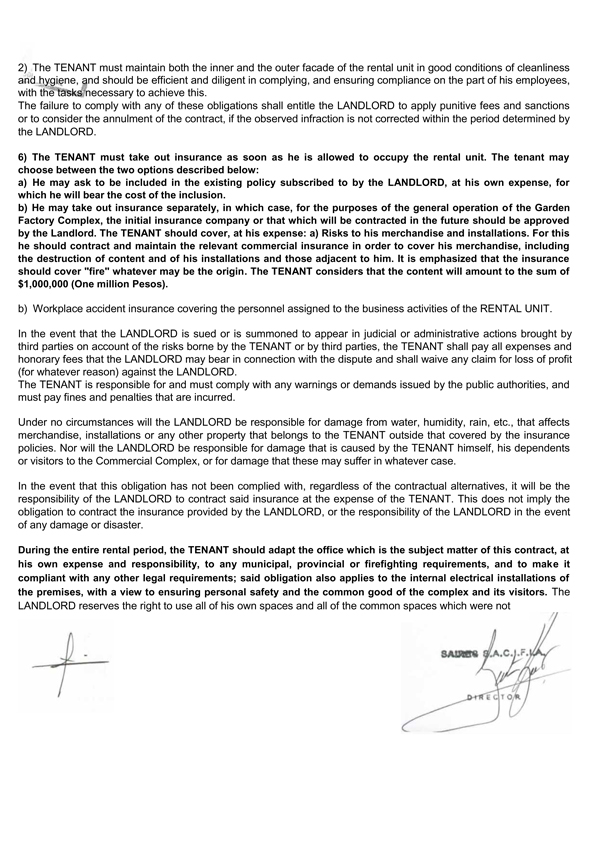
2) The TENANT must maintain both the inner and the outer facade of the rental unit in good conditions of cleanliness and hygiene, and should be efficient and diligent in complying, and ensuring compliance on the part of his employees, with the tasks necessary to achieve this.
The failure to comply with any of these obligations shall entitle the LANDLORD to apply punitive fees and sanctions or to consider the annulment of the contract, if the observed infraction is not corrected within the period determined by the LANDLORD.
6) The TENANT must take out insurance as soon as he is allowed to occupy the rental unit. The tenant may choose between the two options described below:
a) He may ask to be included in the existing policy subscribed to by the LANDLORD, at his own expense, for which he will bear the cost of the inclusion.
b) He may take out insurance separately, in which case, for the purposes of the general operation of the Garden Factory Complex, the initial insurance company or that which will be contracted in the future should be approved by the Landlord. The TENANT should cover, at his expense: a) Risks to his merchandise and installations. For this he should contract and maintain the relevant commercial insurance in order to cover his merchandise, including the destruction of content and of his installations and those adjacent to him. It is emphasized that the insurance should cover “fire” whatever may be the origin. The TENANT considers that the content will amount to the sum of $1,000,000 (One million Pesos).
b) Workplace accident insurance covering the personnel assigned to the business activities of the RENTAL UNIT.
In the event that the LANDLORD is sued or is summoned to appear in judicial or administrative actions brought by third parties on account of the risks borne by the TENANT or by third parties, the TENANT shall pay all expenses and honorary fees that the LANDLORD may bear in connection with the dispute and shall waive any claim for loss of profit (for whatever reason) against the LANDLORD.
The TENANT is responsible for and must comply with any warnings or demands issued by the public authorities, and must pay fines and penalties that are incurred.
Under no circumstances will the LANDLORD be responsible for damage from water, humidity, rain, etc., that affects merchandise, installations or any other property that belongs to the TENANT outside that covered by the insurance policies. Nor will the LANDLORD be responsible for damage that is caused by the TENANT himself, his dependents or visitors to the Commercial Complex, or for damage that these may suffer in whatever case.
In the event that this obligation has not been complied with, regardless of the contractual alternatives, it will be the responsibility of the LANDLORD to contract said insurance at the expense of the TENANT. This does not imply the obligation to contract the insurance provided by the LANDLORD, or the responsibility of the LANDLORD in the event of any damage or disaster.
During the entire rental period, the TENANT should adapt the office which is the subject matter of this contract, at his own expense and responsibility, to any municipal, provincial or firefighting requirements, and to make it compliant with any other legal requirements; said obligation also applies to the internal electrical installations of the premises, with a view to ensuring personal safety and the common good of the complex and its visitors. The LANDLORD reserves the right to use all of his own spaces and all of the common spaces which were not
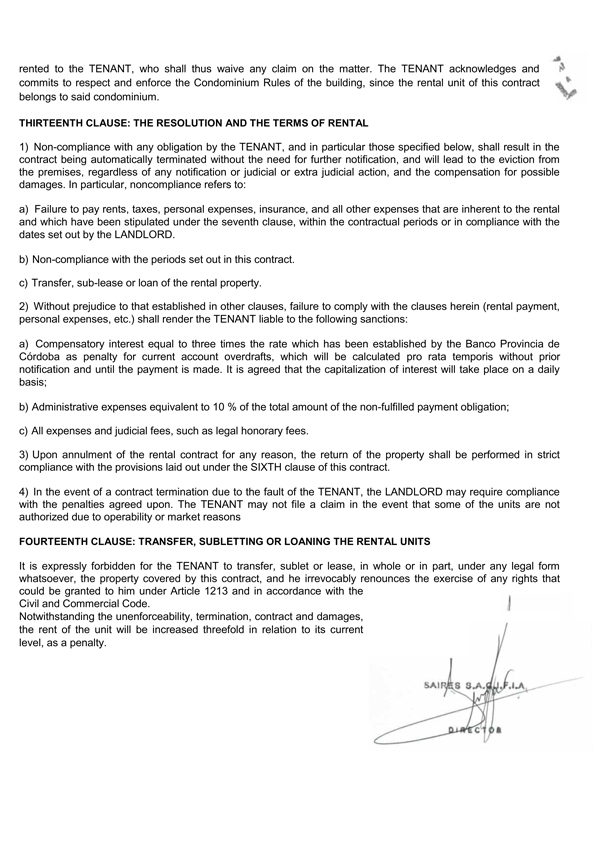
rented to the TENANT, who shall thus waive any claim on the matter. The TENANT acknowledges and commits to respect and enforce the Condominium Rules of the building, since the rental unit of this contract belongs to said condominium.
THIRTEENTH CLAUSE: THE RESOLUTION AND THE TERMS OF RENTAL
1) Non-compliance with any obligation by the TENANT, and in particular those specified below, shall result in the contract being automatically terminated without the need for further notification, and will lead to the eviction from the premises, regardless of any notification or judicial or extra judicial action, and the compensation for possible damages. In particular, noncompliance refers to:
a) Failure to pay rents, taxes, personal expenses, insurance, and all other expenses that are inherent to the rental and which have been stipulated under the seventh clause, within the contractual periods or in compliance with the dates set out by the LANDLORD.
b) Non-compliance with the periods set out in this contract.
c) Transfer, sub-lease or loan of the rental property.
2) Without prejudice to that established in other clauses, failure to comply with the clauses herein (rental payment, personal expenses, etc.) shall render the TENANT liable to the following sanctions:
a) Compensatory interest equal to three times the rate which has been established by the Banco Provincia de Córdoba as penalty for current account overdrafts, which will be calculated pro rata temporis without prior notification and until the payment is made. It is agreed that the capitalization of interest will take place on a daily basis;
b) Administrative expenses equivalent to 10 % of the total amount of the non-fulfilled payment obligation;
c) All expenses and judicial fees, such as legal honorary fees.
3) Upon annulment of the rental contract for any reason, the return of the property shall be performed in strict compliance with the provisions laid out under the SIXTH clause of this contract.
4) In the event of a contract termination due to the fault of the TENANT, the LANDLORD may require compliance with the penalties agreed upon. The TENANT may not file a claim in the event that some of the units are not authorized due to operability or market reasons
FOURTEENTH CLAUSE: TRANSFER, SUBLETTING OR LOANING THE RENTAL UNITS
It is expressly forbidden for the TENANT to transfer, sublet or lease, in whole or in part, under any legal form whatsoever, the property covered by this contract, and he irrevocably renounces the exercise of any rights that could be granted to him under Article 1213 and in accordance with the Civil and Commercial Code.
Notwithstanding the unenforceability, termination, contract and damages, the rent of the unit will be increased threefold in relation to its current level, as a penalty.

FIFTEENTH CLAUSE: REGARDING RESIDENCY
For the purposes of this contract and judicial or extrajudicial notifications, summons and subpoenas, the LANDLORD establishes special domicile at Corrientes 158; and the TENTANT and GUARANTOR do so at Corrientes 161, Garden Factory Complex, in Barrio Centro. All these special addresses correspond to the municipality of the City of Córdoba, in the Province of Córdoba.
SIXTEENTH CLAUSE: JURISDICTION-COMPETENT COURTS
In the event of any dispute in relation to this contract, the contracting parties agree to submit to the jurisdiction of the Ordinary Courts of the City of Córdoba, and renounce Federal Jurisdiction and any other that might correspond to them by exception.
SEVENTEENTH CLAUSE: TAXES AND STAMP TAX
All the taxes, rates, expenses and additional taxes that might be imposed on the activity carried out by the TENANT, either directly or indirectly, will be his sole and exclusive responsibility. The stamp tax charged upon this contract shall be paid in full by the Tenant.
EIGHTEENTH CLAUSE: INTERPRETATION
Despite the fact that the present contract has been classified as rental, thus ceding the tenancy of an individual unit, the parties recognize that there is a multiplicity of relationships that exceed the scope of a rental contract, such as the administration of the Shopping Center, which requires broad abilities and careful, unified policies which are for the common good, in order for the Shopping Center to be an example of commercial development.
NINETEENTH CLAUSE: the TENANT agrees to comply with ANNEX I, which is part of this contract, under the title of Internal Regulation for the Implementation of Electrical Installations in Shops and/or Offices of the Garden Factory Owners’ Consortium.
The LANDLORD has the irrevocable right to interrupt the electricity supply service in the event that the TENANT fails to comply with the aforementioned ANNEX I.
TWENTIETH CLAUSE: As agreed by both parties in this contract, the TENANT may rescind the contract, subject to 60 days’ advance notice to the LANDLORD and the payment of the corresponding termination penalty required by law.
In witness whereof, having read and ratified the contents herein, three copies for one sole purpose are signed in the city of Córdoba, on November 07, 2016.
FIFTEENTH CLAUSE: REGARDING RESIDENCY

CONTRACT ADDENDUM
This Addendum stipulates that the LANDLORD will provide five parking spaces in the Garden Parking Lot, located on the Second Underground Floor, without numbering, for the benefit of the TENANT and free of charge.
These parking spaces are conditional on the effective period of the rental contract once it has been signed, for the second floor of the Garden Factory Complex, and on the payment within terms of the rent, the common expenses and taxes, and of any other costs and previously fixed expenses by the TENANT.
The assignment shall be automatically terminated regardless of any judicial or extrajudicial notice or notification. Once terminated the rental contract, the TENANT undertakes to return the premises, together with the rented space covered by this contract on 11/06/2019.
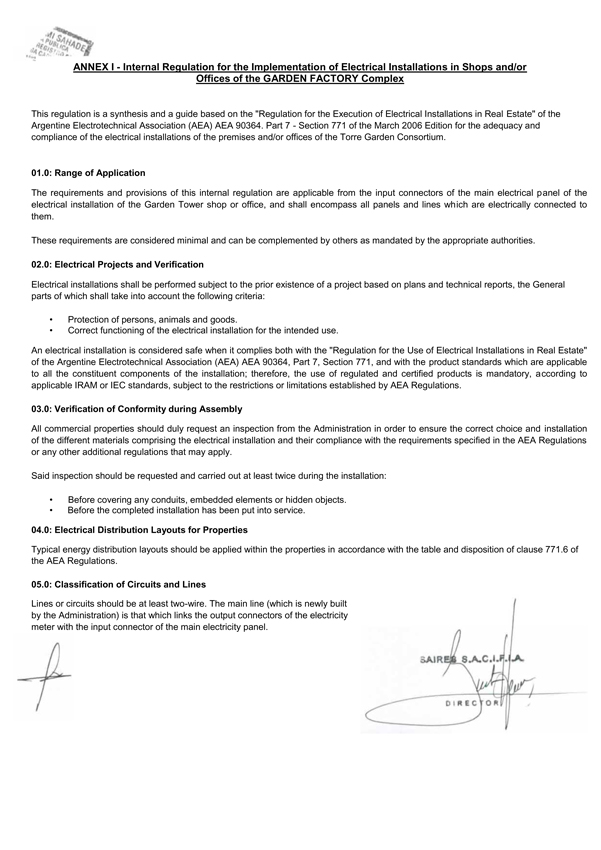
ANNEX I—Internal Regulation for the Implementation of Electrical Installations in Shops and/or
Offices of the GARDEN FACTORY Complex
This regulation is a synthesis and a guide based on the “Regulation for the Execution of Electrical Installations in Real Estate” of the Argentine Electrotechnical Association (AEA) AEA 90364. Part 7—Section 771 of the March 2006 Edition for the adequacy and compliance of the electrical installations of the premises and/or offices of the Torre Garden Consortium.
01.0: Range of Application
The requirements and provisions of this internal regulation are applicable from the input connectors of the main electrical panel of the electrical installation of the Garden Tower shop or office, and shall encompass all panels and lines which are electrically connected to them.
These requirements are considered minimal and can be complemented by others as mandated by the appropriate authorities.
02.0: Electrical Projects and Verification
Electrical installations shall be performed subject to the prior existence of a project based on plans and technical reports, the General parts of which shall take into account the following criteria:
Protection of persons, animals and goods.
Correct functioning of the electrical installation for the intended use.
An electrical installation is considered safe when it complies both with the “Regulation for the Use of Electrical Installations in Real Estate” of the Argentine Electrotechnical Association (AEA) AEA 90364, Part 7, Section 771, and with the product standards which are applicable to all the constituent components of the installation; therefore, the use of regulated and certified products is mandatory, according to applicable IRAM or IEC standards, subject to the restrictions or limitations established by AEA Regulations.
03.0: Verification of Conformity during Assembly
All commercial properties should duly request an inspection from the Administration in order to ensure the correct choice and installation of the different materials comprising the electrical installation and their compliance with the requirements specified in the AEA Regulations or any other additional regulations that may apply.
Said inspection should be requested and carried out at least twice during the installation:
Before covering any conduits, embedded elements or hidden objects.
Before the completed installation has been put into service.
04.0: Electrical Distribution Layouts for Properties
Typical energy distribution layouts should be applied within the properties in accordance with the table and disposition of clause 771.6 of the AEA Regulations.
05.0: Classification of Circuits and Lines
Lines or circuits should be at least two-wire. The main line (which is newly built by the Administration) is that which links the output connectors of the electricity meter with the input connector of the main electricity panel.
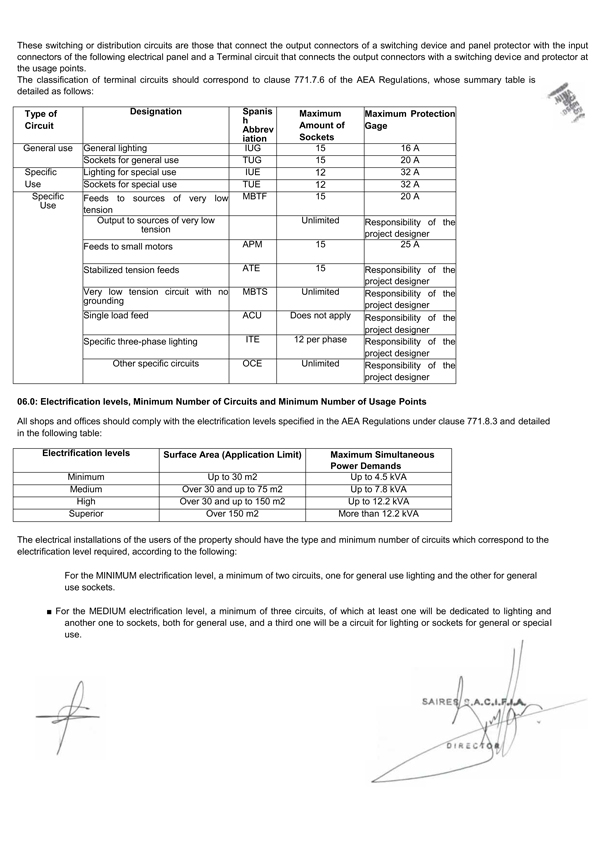
These switching or distribution circuits are those that connect the output connectors of a switching device and panel protector with the input connectors of the following electrical panel and a Terminal circuit that connects the output connectors with a switching device and protector at the usage points.
The classification of terminal circuits should correspond to clause 771.7.6 of the AEA Regulations, whose summary table is detailed as follows:
Type of Circuit Designation Spanish Abbreviation Maximum Amount of Sockets Maximum Protection Gage
General use General lighting IUG 15 16 A
Sockets for general use TUG 15 20 A
Specific
Use Lighting for special use IUE 12 32 A
Sockets for special use TUE 12 32 A
Specific
Use Feeds to sources of very low tension MBTF 15 20 A
Output to sources of very low tension Unlimited Responsibility of the project designer
Feeds to small motors APM 15 25 A
Stabilized tension feeds ATE 15 Responsibility of the project designer
Very low tension circuit with no grounding MBTS Unlimited Responsibility of the project designer
Single load feed ACU Does not apply Responsibility of the project designer
Specific three-phase lighting ITE 12 per phase Responsibility of the project designer
Other specific circuits OCE Unlimited Responsibility of the project designer
06.0: Electrification levels, Minimum Number of Circuits and Minimum Number of Usage Points
All shops and offices should comply with the electrification levels specified in the AEA Regulations under clause 771.8.3 and detailed in the following table:
Electrification levels Surface Area (Application Limit) Maximum Simultaneous Power Demands
Minimum Up to 30 m2 Up to 4.5 kVA
Medium Over 30 and up to 75 m2 Up to 7.8 kVA
High Over 30 and up to 150 m2 Up to 12.2 kVA
Superior Over 150 m2 More than 12.2 kVA
The electrical installations of the users of the property should have the type and minimum number of circuits which correspond to the electrification level required, according to the following:
For the MINIMUM electrification level, a minimum of two circuits, one for general use lighting and the other for general use sockets.
? For the MEDIUM electrification level, a minimum of three circuits, of which at least one will be dedicated to lighting and another one to sockets, both for general use, and a third one will be a circuit for lighting or sockets for general or special use.
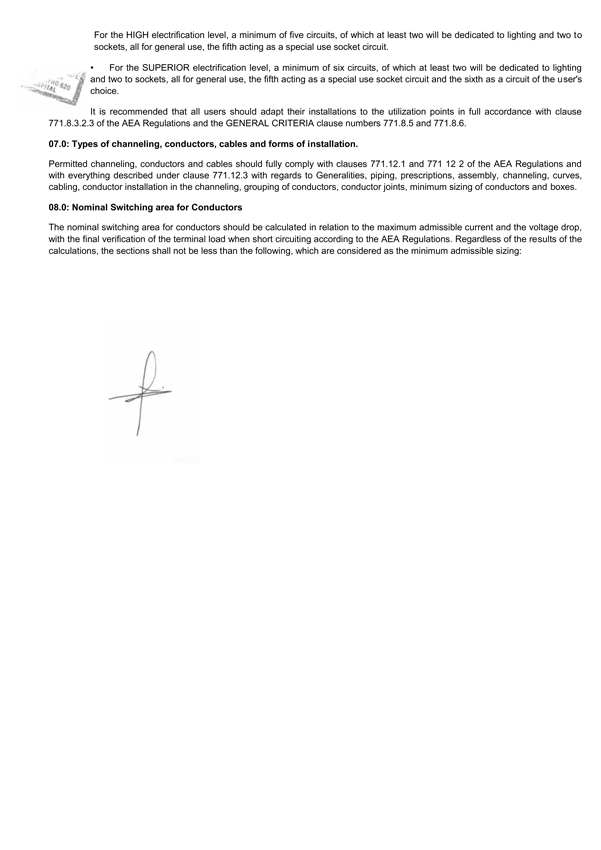
For the HIGH electrification level, a minimum of five circuits, of which at least two will be dedicated to lighting and two to sockets, all for general use, the fifth acting as a special use socket circuit.
For the SUPERIOR electrification level, a minimum of six circuits, of which at least two will be dedicated to lighting and two to sockets, all for general use, the fifth acting as a special use socket circuit and the sixth as a circuit of the user’s choice.
It is recommended that all users should adapt their installations to the utilization points in full accordance with clause 771.8.3.2.3 of the AEA Regulations and the GENERAL CRITERIA clause numbers 771.8.5 and 771.8.6.
07.0: Types of channeling, conductors, cables and forms of installation.
Permitted channeling, conductors and cables should fully comply with clauses 771.12.1 and 771 12 2 of the AEA Regulations and with everything described under clause 771.12.3 with regards to Generalities, piping, prescriptions, assembly, channeling, curves, cabling, conductor installation in the channeling, grouping of conductors, conductor joints, minimum sizing of conductors and boxes.
08.0: Nominal Switching area for Conductors
The nominal switching area for conductors should be calculated in relation to the maximum admissible current and the voltage drop, with the final verification of the terminal load when short circuiting according to the AEA Regulations. Regardless of the results of the calculations, the sections shall not be less than the following, which are considered as the minimum admissible sizing:
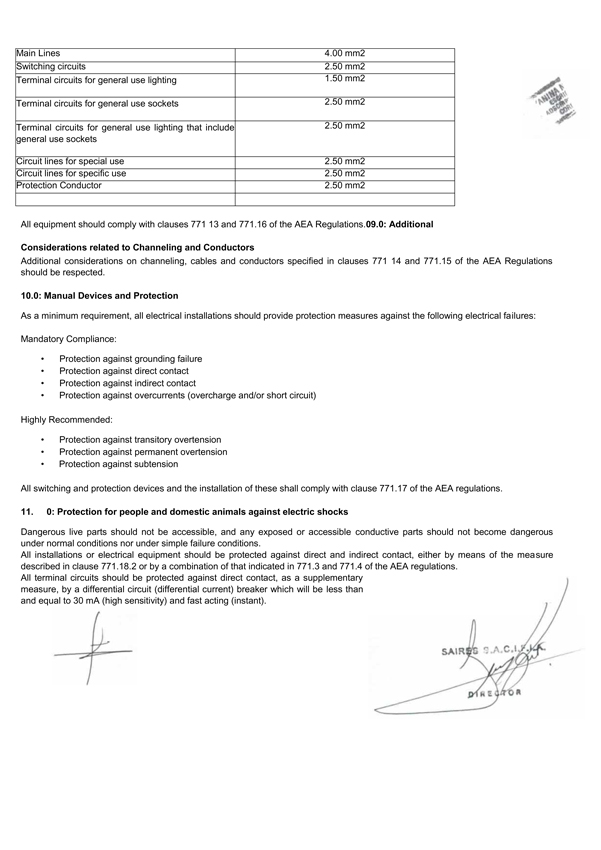
Main Lines 4.00 mm2
Switching circuits 2.50 mm2
Terminal circuits for general use lighting 1.50 mm2
Terminal circuits for general use sockets 2.50 mm2
Terminal circuits for general use lighting that include general use sockets 2.50 mm2
Circuit lines for special use 2.50 mm2
Circuit lines for specific use 2.50 mm2
Protection Conductor 2.50 mm2
All equipment should comply with clauses 771 13 and 771.16 of the AEA Regulations.09.0: Additional Considerations related to Channeling and Conductors
Additional considerations on channeling, cables and conductors specified in clauses 771 14 and 771.15 of the AEA Regulations should be respected.
10.0: Manual Devices and Protection
As a minimum requirement, all electrical installations should provide protection measures against the following electrical failures:
Mandatory Compliance:
Protection against grounding failure
Protection against direct contact
Protection against indirect contact
Protection against overcurrents (overcharge and/or short circuit)
Highly Recommended:
Protection against transitory overtension
Protection against permanent overtension
Protection against subtension
All switching and protection devices and the installation of these shall comply with clause 771.17 of the AEA regulations.
11. 0: Protection for people and domestic animals against electric shocks
Dangerous live parts should not be accessible, and any exposed or accessible conductive parts should not become dangerous under normal conditions nor under simple failure conditions.
All installations or electrical equipment should be protected against direct and indirect contact, either by means of the measure described in clause 771.18.2 or by a combination of that indicated in 771.3 and 771.4 of the AEA regulations.
All terminal circuits should be protected against direct contact, as a supplementary measure, by a differential circuit (differential current) breaker which will be less than and equal to 30 mA (high sensitivity) and fast acting (instant).
Minimum Conductor Switchings
Minimum Conductor Switchings

In particular, general and special use lighting circuits, special and general use socket circuits, and specific use circuits should be protected at all times against direct contact, as an additional measure, by differential fast acting or instantaneous circuit breakers characterized by a maximum sensitivity of 30 mA and fully complying with IRAM 2301, IEC 61008 or IRAM NM IEC 61009 standards.
12.0: Characteristics of a Grounding Conductor
The grounding of accessible conductors will be carried out using a conductor, known as a protective earth (PE), made of isolated electrolytic copper complying with IRAM NM 247-3, IRAM 2178, IRAM 62266 or IRAM 62267 standards, throughout the installation, including boxes and outlets without sockets, which shall enter through the main electrical panel to its terminals. The required minimum nominal section is set out in Table 771 18 III of the AEA Regulation and must comply with clauses 771 18 5 6 and 771.18.5.7 of said regulations. This conductor cannot be interrupted or switched.
13.0: Protection of Installations
In all installations, protection devices should be programmed to interrupt all overcharge currents in the conductors of a circuit before they can cause damage by heating the insulation, the connections, the terminals or the area surrounding the conductors, and that indicated in clause 771.19 of the AEA Regulations should be respected.
14.0: Electrical Panels
The panels shall be made of boxes or cabinets containing connection, switching, control, measurement, protection and signaling devices with their respective wiring, busbars, covers and supports. Said panels should be standardized and certified according to IEC 60439-1 and the additional requirements of IEC 60439-3, in order to be used in alternating currents not exceeding 300 V to earth; where the total current feed does not exceed 250 A, and where the output circuits include protection devices against short circuiting, they should all have an assigned current not exceeding 125 A and they should be designed for indoor use and/or offices or other places where unqualified or ordinary people may have direct access when in service. Attention should be paid to and full compliance should be ensured with clause 771 20 of the AEA Regulations.
The panel(s) should be adapted to conform with clause 771.20 of the cited regulation with regards to the installation location, placement, IP Grade, construction, signaling, thermal behavior, access to amplifications and maintenance.
15.0 Inspection and Maintenance of the Installations
Electrical installations must be subject to prior inspections and to an initial inspection before being put into service or whenever a modification of the periodic inspection schedule established by this administration is made. The inspections shall be carried out to ensure that the installations have been performed in accordance with the requirements of “The Regulation for the Execution of Electrical Installations in Real Estate” of the Argentine Electrotechnical Association (AEA) AEA 90364, Part 7—Section 771. They shall also determine the necessary maintenance tasks set forth under clause 771.23 of the aforementioned regulations.
The electrical installations should be reviewed periodically and maintained in good condition, preserving the original characteristics of each of its components. All anomalies should be corrected through replacement or repair by competent personnel. When replacing elements, only those standardized by IRAM or IEC shall be used.
If the short circuit, overcharge or direct or indirect contact protection devices are activated without a known cause, a detailed review of the installation must be carried out prior to restoring power.
16.0: Lighting Fixtures and Lighting Installations
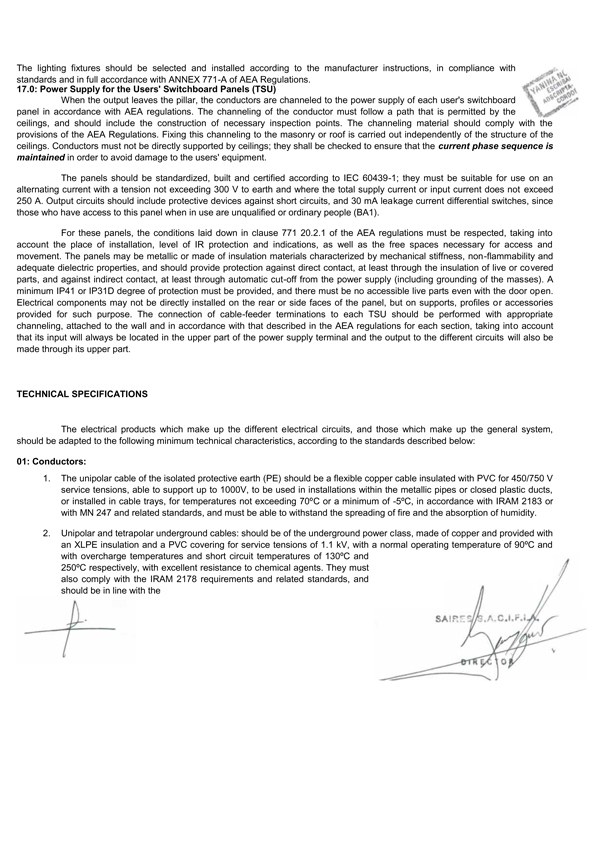
The lighting fixtures should be selected and installed according to the manufacturer instructions, in compliance with standards and in full accordance with ANNEX 771-A of AEA Regulations.
17.0: Power Supply for the Users’ Switchboard Panels (TSU)
When the output leaves the pillar, the conductors are channeled to the power supply of each user’s switchboard panel in accordance with AEA regulations. The channeling of the conductor must follow a path that is permitted by the ceilings, and should include the construction of necessary inspection points. The channeling material should comply with the provisions of the AEA Regulations. Fixing this channeling to the masonry or roof is carried out independently of the structure of the ceilings. Conductors must not be directly supported by ceilings; they shall be checked to ensure that the current phase sequence is maintained in order to avoid damage to the users’ equipment.
The panels should be standardized, built and certified according to IEC 60439-1; they must be suitable for use on an alternating current with a tension not exceeding 300 V to earth and where the total supply current or input current does not exceed 250 A. Output circuits should include protective devices against short circuits, and 30 mA leakage current differential switches, since those who have access to this panel when in use are unqualified or ordinary people (BA1).
For these panels, the conditions laid down in clause 771 20.2.1 of the AEA regulations must be respected, taking into account the place of installation, level of IR protection and indications, as well as the free spaces necessary for access and movement. The panels may be metallic or made of insulation materials characterized by mechanical stiffness, non-flammability and adequate dielectric properties, and should provide protection against direct contact, at least through the insulation of live or covered parts, and against indirect contact, at least through automatic cut-off from the power supply (including grounding of the masses). A minimum IP41 or IP31D degree of protection must be provided, and there must be no accessible live parts even with the door open. Electrical components may not be directly installed on the rear or side faces of the panel, but on supports, profiles or accessories provided for such purpose. The connection of cable-feeder terminations to each TSU should be performed with appropriate channeling, attached to the wall and in accordance with that described in the AEA regulations for each section, taking into account that its input will always be located in the upper part of the power supply terminal and the output to the different circuits will also be made through its upper part.
TECHNICAL SPECIFICATIONS
The electrical products which make up the different electrical circuits, and those which make up the general system, should be adapted to the following minimum technical characteristics, according to the standards described below:
01: Conductors:
1. The unipolar cable of the isolated protective earth (PE) should be a flexible copper cable insulated with PVC for 450/750 V service tensions, able to support up to 1000V, to be used in installations within the metallic pipes or closed plastic ducts, or installed in cable trays, for temperatures not exceeding 70ºC or a minimum of -5ºC, in accordance with IRAM 2183 or with MN 247 and related standards, and must be able to withstand the spreading of fire and the absorption of humidity.
2. Unipolar and tetrapolar underground cables: should be of the underground power class, made of copper and provided with an XLPE insulation and a PVC covering for service tensions of 1.1 kV, with a normal operating temperature of 90ºC and with overcharge temperatures and short circuit temperatures of 130ºC and 250ºC respectively, with excellent resistance to chemical agents. They must also comply with the IRAM 2178 requirements and related standards, and should be in line with the
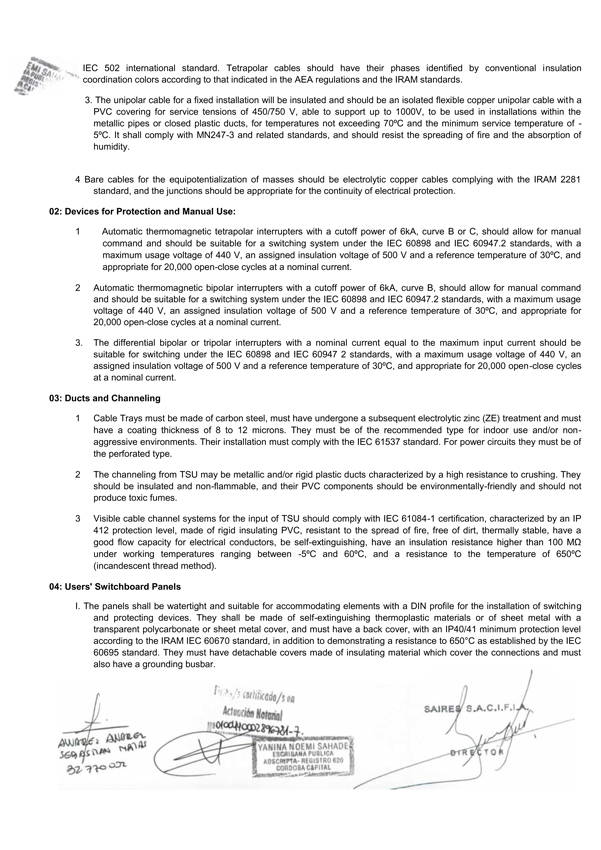
IEC 502 international standard. Tetrapolar cables should have their phases identified by conventional insulation coordination colors according to that indicated in the AEA regulations and the IRAM standards.
3. The unipolar cable for a fixed installation will be insulated and should be an isolated flexible copper unipolar cable with a PVC covering for service tensions of 450/750 V, able to support up to 1000V, to be used in installations within the metallic pipes or closed plastic ducts, for temperatures not exceeding 70ºC and the minimum service temperature of -5ºC. It shall comply with MN247-3 and related standards, and should resist the spreading of fire and the absorption of humidity.
4 Bare cables for the equipotentialization of masses should be electrolytic copper cables complying with the IRAM 2281 standard, and the junctions should be appropriate for the continuity of electrical protection.
02: Devices for Protection and Manual Use:
1 Automatic thermomagnetic tetrapolar interrupters with a cutoff power of 6kA, curve B or C, should allow for manual command and should be suitable for a switching system under the IEC 60898 and IEC 60947.2 standards, with a maximum usage voltage of 440 V, an assigned insulation voltage of 500 V and a reference temperature of 30ºC, and appropriate for 20,000 open-close cycles at a nominal current.
2 Automatic thermomagnetic bipolar interrupters with a cutoff power of 6kA, curve B, should allow for manual command and should be suitable for a switching system under the IEC 60898 and IEC 60947.2 standards, with a maximum usage voltage of 440 V, an assigned insulation voltage of 500 V and a reference temperature of 30ºC, and appropriate for 20,000 open-close cycles at a nominal current.
3. The differential bipolar or tripolar interrupters with a nominal current equal to the maximum input current should be suitable for switching under the IEC 60898 and IEC 60947 2 standards, with a maximum usage voltage of 440 V, an assigned insulation voltage of 500 V and a reference temperature of 30ºC, and appropriate for 20,000 open-close cycles at a nominal current.
03: Ducts and Channeling
1 Cable Trays must be made of carbon steel, must have undergone a subsequent electrolytic zinc (ZE) treatment and must have a coating thickness of 8 to 12 microns. They must be of the recommended type for indoor use and/or non-aggressive environments. Their installation must comply with the IEC 61537 standard. For power circuits they must be of the perforated type.
2 The channeling from TSU may be metallic and/or rigid plastic ducts characterized by a high resistance to crushing. They should be insulated and non-flammable, and their PVC components should be environmentally-friendly and should not produce toxic fumes.
3 Visible cable channel systems for the input of TSU should comply with IEC 61084-1 certification, characterized by an IP 412 protection level, made of rigid insulating PVC, resistant to the spread of fire, free of dirt, thermally stable, have a good flow capacity for electrical conductors, be self-extinguishing, have an insulation resistance higher than 100 M? under working temperatures ranging between -5ºC and 60ºC, and a resistance to the temperature of 650ºC (incandescent thread method).
04: Users’ Switchboard Panels
I. The panels shall be watertight and suitable for accommodating elements with a DIN profile for the installation of switching and protecting devices. They shall be made of self-extinguishing thermoplastic materials or of sheet metal with a transparent polycarbonate or sheet metal cover, and must have a back cover, with an IP40/41 minimum protection level according to the IRAM IEC 60670 standard, in addition to demonstrating a resistance to 650°C as established by the IEC 60695 standard. They must have detachable covers made of insulating material which cover the connections and must also have a grounding busbar.
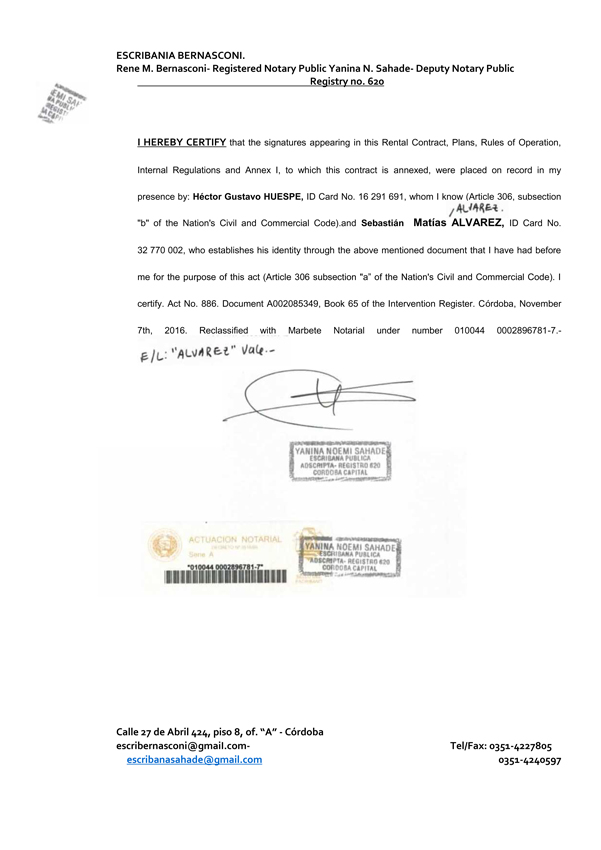
ESCRIBANIA BERNASCONI.
Rene M. Bernasconi- Registered Notary Public Yanina N. Sahade- Deputy Notary Public
Registry no. 620
[GRAPHIC APPEARS HERE] I HEREBY CERTIFY that the signatures appearing in this Rental Contract, Plans, Rules of Operation, Internal Regulations and Annex I, to which this contract is annexed, were placed on record in my presence by: Héctor Gustavo HUESPE, ID Card No. 16 291 691, whom I know (Article 306, subsection “b” of the Nation’s Civil and Commercial Code).and Sebastián Matías ALVAREZ, ID Card No. 32 770 002, who establishes his identity through the above mentioned document that I have had before me for the purpose of this act (Article 306 subsection “a” of the Nation’s Civil and Commercial Code). I certify. Act No. 886. Document A002085349, Book 65 of the Intervention Register. Córdoba, November 7th, 2016. Reclassified with Marbete Notarial under number 010044 0002896781-7.-
Calle 27 de Abril 424, piso 8, of. “A”—Córdoba
escribernasconi@gmaiI.com- Tel/Fax: 0351-4227805
escribanasahade@gmail.com 0351-4240597
